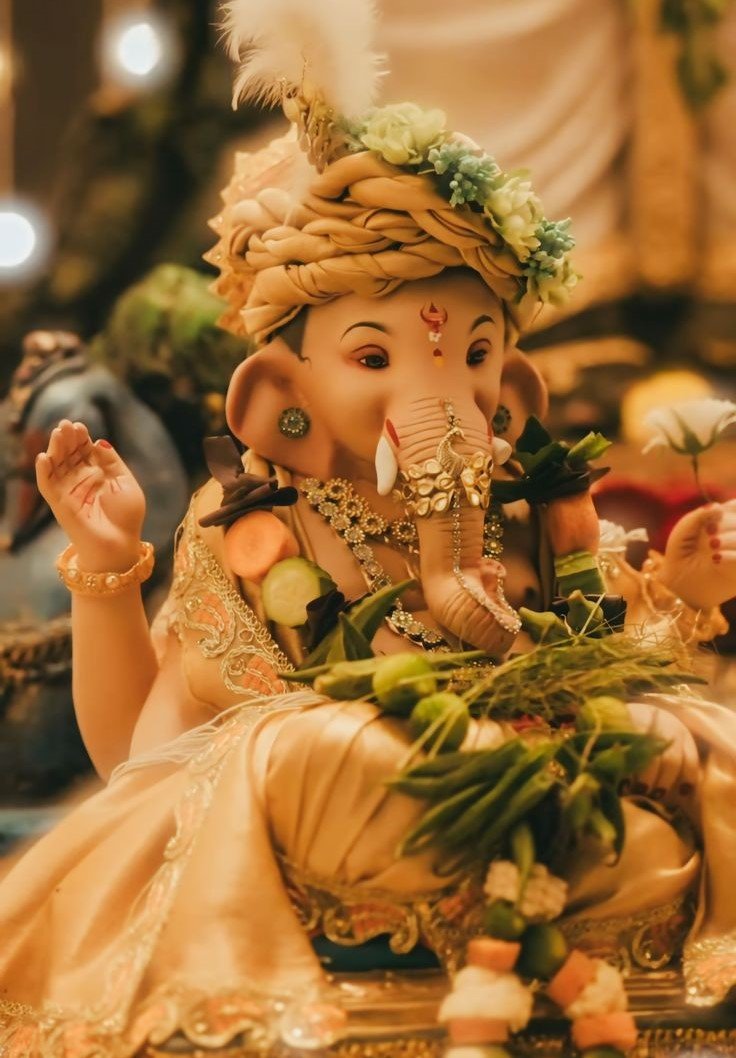From South to North: Ganesh Chaturthi's Enchanting Tale
Ganesh Chaturthi is celebrated with a great zeal in India but how many of us knows about it's true origin? With this blog, let's learn about its immergence in north.

Ganesh Chaturthi, well known as Ganapati Chaturthi, is a festival that brings the air of joy, devotion, and celebration all across India. While the roots of this celebration are deeply seated in the southern states, the lively celebration of this festival has also spread to the north, creating a beautiful blend of tradition and modern rituals. Let us all together explore this enchanting journey of Ganesh Chaturthi.
The Origin of Ganesh Chaturthi
The celebration of Ganesh Chaturthi begins with the story of Lord Ganesha’s birth, which is celebrated on the 4th day of the Bhadrapada month in the Hindu calendar. According to Hindu mythology, Lord Ganesha was created by Goddess Parvati, the consort of Lord Shiva, during a time when Lord Shiva was away from home.
As the story goes, Goddess Parvati, seeking privacy, created Ganesha from the clay of her body and breathed life into him. She asked him a guard the door and watch over her while she bathed. When Lord Shiva returned, he was surprised to find a young boy blocking his entry. In his anger, Shiva, not knowing that the boy was his own son, beheaded Ganesha.
Upon realizing the mistake, a grief-stricken Shiva ordered his followers to bring back the head of any creature they could find. The first being they found was an elephant, and so Lord Shiva placed the elephant's head on Ganesha's body, and brought him back to life.
While Ganesh Puja is widely celebrated in the southern states, the ritual has vastly evolved and spread to northern regions like Maharashtra, Uttar Pradesh, and Madhya Pradesh. The reasons for this growing popularity range from devotion to the beauty of the idol decorations.
Ganesh Puja and Its Rituals
The worship of Lord Ganesha is at the heart of the Ganesh Puja, where devotees offer prayers, flowers, sweets (especially Lord Ganesh’s favourite modaks), and perform aarti. The key rituals of this celebrations are:
- Ganapati Pooja: The main prayer ceremony where Lord Ganesha is welcomed into the home with a beautiful idol.
- Decoration for Vinayaka Chavithi: Homes and pandals are decorated with flowers, lights, and colorful rangolis, making the environment vibrant and festive.
- Ganesh Visarjan: On the last day of celebration, the idol is immersed in water, which symbolizes the return of Ganesha to his heavenly abode. This marks the end of the festival with chants of “Ganapati Bappa Morya”.
These rituals are a common practice not just in southern states but throughout the India, which that how Ganesh Chaturthi has become a pan-Indian celebration.
Ganesh Chaturthi in the South vs North
The roots of Ganesh Chaturthi lie in South India, especially in states like Maharashtra, Karnataka, and Tamil Nadu, where this festival is celebrated with great enthusiasm. The states of south India have an ancient tradition of honoring Lord Ganesha, and over the time, these rituals have evolved into vibrant public celebrations.
In contrast to this, the celebration of Ganesh Chaturthi in northern India was not that prominent initially. However, it did gain acceptance and growing intensity over the years, especially with the efforts of great figures like Lokmanya Tilak in the early 20th century. During that time, his main aim was to unite people and provide them with a sense of nationalism, and what could have been a better way than through the celebration of Ganapati?
Now, in areas like Agra, Delhi, and Jaipur, Ganesh Puja has become an annual event that attracts huge crowds, with grand public processions and large idols, while also keeping the traditional rituals intact.
About Ganesh Chaturthi Decorations and Pandals
One of the biggest highlights of Ganesh Chaturthi is the stunning decoration for Vinayaka Chavithi. The pandals, which are the temporary structures for Lord Ganesha, are decorated with detailed artworks, lights, and themes that go from traditional to modern. These pandals have become places for community gatherings, where people come together for prayers, music, and a shared sense of joy.
As the festival spreads from the South to the North, decorations have become grander and grander, with fancy themes based on movies, history, and mythology. These vibrant creations have made the celebration of Ganesh Chaturthi a feast for the eyes.
The Significance of Ganesh Visarjan
The final act of Ganesh Visarjan holds a very deep meaning. It represents the cycle of life and the inevitability of change. The immersion of the idol of Ganesh into water symbolizes the return of the lord to his heavenly abode. People bid farewell to Lord Ganesh with hopes for his speedy return the next year.
In both South and North India, Ganesh Chaturthi concludes with a joyful Ganesh Visarjan, marked by colorful processions, dancing, and chanting. This is not only a moment of devotion but also of community spirit.
Conclusion
From the beginning of this festival from South India to the widespread of its celebration across the North, Ganesh Chaturthi has now become an occasion that brings people together with joy, devotion, and pride on their culture. The festival is not just rituals anymore; it is a celebration of life, of great blessings bestowed by Lord Ganesh, and of the unity that bring the people across India as one, regardless of the region they come from.
Whether it is in the peaceful temples south or the bustling pandals in north, the celebration of Ganesh Chaturthi always remains as a symbol of faith, family, and community.




-(1).png)
.png)
